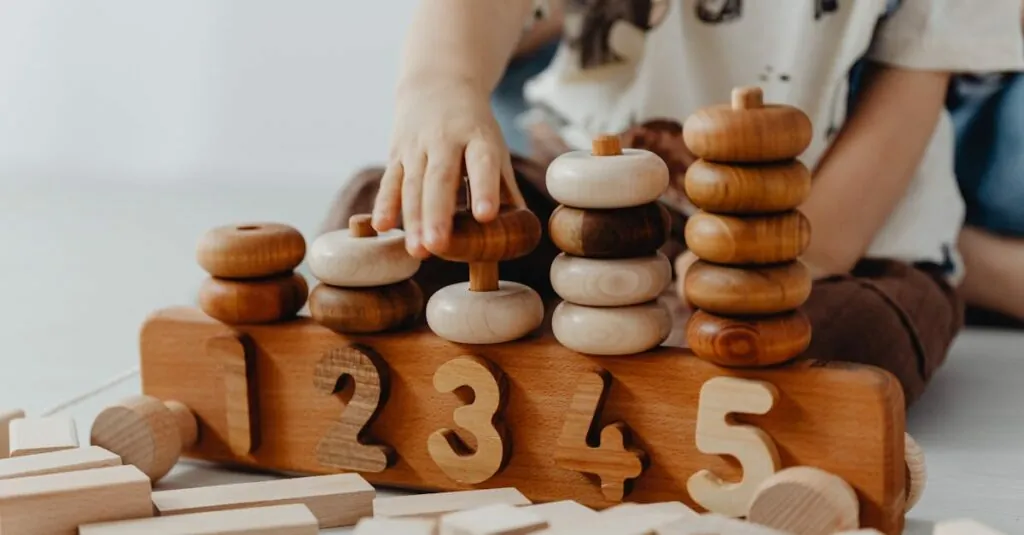Counting isn’t just about numbers; it’s an adventure waiting to unfold in preschool! Imagine tiny hands eagerly raising fingers while giggles fill the air. Preschoolers can explore the magical world of counting through fun activities that spark their curiosity and creativity.
Table of Contents
ToggleWhat Are Counting Activities for Preschool?
Counting activities for preschool focus on engaging young learners in the foundational concepts of numbers and quantity. These hands-on experiences stimulate curiosity while fostering essential math skills in a fun environment. Learning through play captures children’s attention and enhances their understanding.
Examples of counting activities include using everyday objects like blocks, buttons, or fruits. Children can count items during sorting games or while assembling crafts. Grouping objects into sets encourages comparative thinking, helping preschoolers recognize quantities and their relationships.
Interactive games, such as “Counting Songs,” introduce rhythm and rhyme, creating an enjoyable way to learn numbers. Teachers can incorporate movement, asking children to jump or clap for each number they count, reinforcing physical engagement alongside mental comprehension.
Visual aids, like number charts and counting mats, support visual learners. Utilizing bright colors and fun designs captures interest and simplifies the concept of counting. The combination of auditory, visual, and kinesthetic activities ensures a well-rounded approach to learning.
Counting activities often integrate themes involving animals, nature, or the classroom, making them relatable and stimulating. For instance, children might count the number of animals in a story or the number of leaves collected during a nature walk. Creative contexts provide additional layers to the learning experience, resulting in better retention of counting skills.
Ultimately, these activities equip preschoolers with confidence and foundational math knowledge. Preschool teachers play a crucial role in designing engaging ways for children to explore numbers, ensuring they build a positive relationship with math from an early age.
Benefits of Counting Activities
Counting activities provide significant advantages for preschoolers. Engaging in these activities nurtures early math skills while fostering essential developmental milestones.
Cognitive Development
Counting activities promote cognitive development by enhancing critical thinking and problem-solving skills. Young learners engage in sorting and classifying objects, which builds their ability to categorize information. Additionally, these activities encourage memory retention through repetition, reinforcing number recognition and sequencing. As preschoolers participate in games that involve counting, they learn to connect numbers with quantities, fostering numerical understanding. This foundation supports future math concepts, such as addition and subtraction, ensuring they gain confidence in their abilities.
Social Skills Enhancement
Participating in counting activities enhances social skills among preschoolers. Collaboration occurs naturally during group games, as they share materials and take turns. Engaging with peers fosters communication skills, encouraging them to express their thoughts and understand others. Furthermore, group activities allow for the development of patience and empathy, as children learn to support each other’s learning journeys. The joy found in shared counting experiences helps create strong social bonds, improving their overall interaction and teamwork capabilities.
Types of Counting Activities
Preschool encompasses various engaging counting activities. These activities enhance foundational math skills while offering playful experiences.
Interactive Games
Interactive games provide hands-on experiences for preschoolers. Counting games, like scavenger hunts, encourage children to find and tally objects. Board games with number layouts stimulate counting practice in a fun setting. Simple digital apps engage young learners in exciting ways, often incorporating animation and sounds to captivate attention. Group-based activities promote social interaction, allowing children to collaborate on strategies while reinforcing number recognition.
Arts and Crafts
Arts and crafts activities turn counting into a creative process. Children can create collages using cut-out shapes, reinforcing quantity concepts as they count pieces. Bead stringing offers opportunities to count and design patterns, enhancing fine motor skills along with math learning. Clay modeling encourages counting and estimating shapes while making tactile experiences enjoyable. These activities tap into visual learning styles, making counting meaningful and relatable.
Songs and Rhymes
Songs and rhymes capture preschoolers’ attention, blending music and counting. Catchy counting songs help children memorize numbers through repetition and rhythm. Nursery rhymes often incorporate counting elements, seamlessly integrating math into storytelling. Action songs promote physical movement, linking body movements with numbers for better retention. This musical approach facilitates language development, aiding in math fluency as children sing along.
Tips for Implementing Counting Activities
Implementing counting activities requires thoughtful planning and execution. Educators can enhance learning by creating engaging environments and involving parents.
Creating a Fun Learning Environment
Creating a fun learning environment captures preschoolers’ attention and fosters curiosity. Incorporating bright colors and playful decorations makes the space inviting. Using everyday objects, such as blocks and fruits, allows children to explore numbers through tangible experiences. Rhythm and movement in counting songs spark enthusiasm and keep learners engaged. Arranging interactive stations with age-appropriate materials promotes hands-on involvement. Lastly, positive reinforcement during counting tasks encourages confidence and participation, making learning enjoyable and effective.
Involving Parents and Caregivers
Involving parents and caregivers strengthens the impact of counting activities at home. Sharing resources allows families to incorporate counting into daily routines, such as mealtime or grocery shopping. Suggesting simple games helps families engage their children in learning outside the classroom. Organizing family events encourages collaboration between educators and families, creating a support network. Providing regular feedback on children’s progress keeps parents informed and motivated to assist. Effective communication between teachers and families enhances the child’s counting experience and establishes a consistent learning approach.
Counting activities for preschoolers play a vital role in shaping their early math skills and social interactions. Through engaging and playful experiences, children not only learn to recognize numbers but also develop critical thinking and problem-solving abilities. These activities foster a love for learning that can last a lifetime.
By incorporating various methods such as interactive games and creative projects, educators can create a dynamic learning environment that captures children’s attention. When parents and caregivers get involved, the impact of these activities expands even further, reinforcing skills at home. Ultimately, a strong foundation in counting paves the way for future success in math and enhances overall development in young learners.

